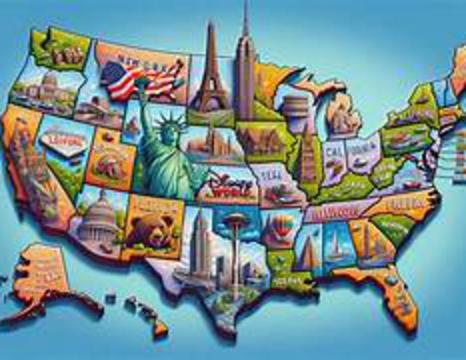Privacy Policy | Terms of Use | Cookie Policy | Disclaimer
Empowering the American middle class — one story at a time.
The Growth of a Nation
In the years following America's independence and the creation of the Constitution, the United States began an ambitious journey—one that would transform it from a fledgling republic into a rapidly growing, powerful nation. This period, often overlooked in favor of the Revolutionary War or Civil War, was essential in shaping the country's economy, identity, and values. At the center of this transformation were ordinary Americans: farmers, builders, factory workers, shopkeepers, and immigrants whose hard work created the foundation for the American middle class.
As the 19th century unfolded, the country expanded westward with tremendous speed. The Louisiana Purchase in 1803 opened vast new territories. The idea of Manifest Destiny took hold, encouraging Americans to settle the West and spread their way of life across the continent. This movement brought challenges and displacement, but it also spurred massive growth. Settlers cleared land, built homes, and created new towns. Railroads, canals, and turnpikes connected the nation from coast to coast, transforming local markets into a national economy.
With expansion came industrialization. The rise of factories in the North and the emergence of new technologies like the cotton gin and steam engine changed how Americans lived and worked. Instead of relying solely on local farming, people began to work for wages in mills, foundries, and shops. Urban centers grew, and a new kind of worker emerged: someone who earned a living not from land ownership, but from labor. These men and women became the backbone of the growing economy and helped shape what we now understand as the middle class.
Immigration played a central role during this era. Millions of people arrived in America from Ireland, Germany, Italy, Eastern Europe, and China. Many came to escape poverty, famine, or political turmoil. They brought skills, culture, and a willingness to work hard, often taking on the most difficult and dangerous jobs in construction, mining, transportation, and factories. Though often met with prejudice and exploitation, these immigrants powered the engines of American growth and laid deep roots that still shape our communities today.
Throughout this period, Americans began organizing for better conditions. Workers demanded shorter hours, safer workplaces, and fairer treatment. Farmers formed cooperatives and alliances to resist corporate monopolies. The seeds of labor unions were planted. Though the road was long and progress slow, these early movements were vital in securing rights that future generations would benefit from—rights that define modern middle-class life, such as weekends, overtime pay, and workplace safety.
Women, too, played an essential role. While often excluded from political power, they were deeply involved in family farms, local economies, and later the workforce. Women began to organize for education, suffrage, and equality, setting the stage for future social progress. Their voices were critical in building communities, churches, schools, and social institutions that helped anchor America’s moral and civic life.
The growth of the nation was not only about land and money—it was about people and purpose. The American ideal of progress was deeply tied to fairness, hard work, and the belief that every person deserved a chance to improve their life. This period built more than infrastructure; it built an identity. It helped forge the belief that through unity, perseverance, and shared sacrifice, a better future could be achieved—not just for the wealthy, but for all Americans.
Today, as we examine the challenges facing the modern middle class, we must remember these origins. The strength of America has always come from its people. The farmers who tilled the land, the laborers who built the rails, the immigrants who dreamed of a better life, and the families who struggled and endured—they are the true architects of our national legacy. By honoring their contributions and continuing their work, we can build a country that lives up to the promise they worked so hard to create.

